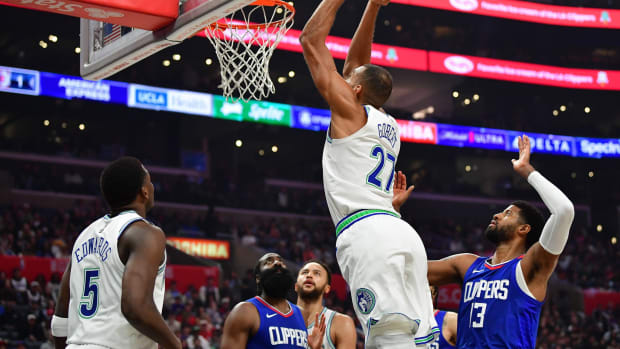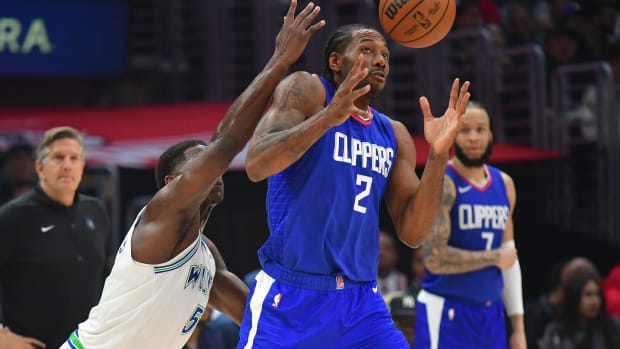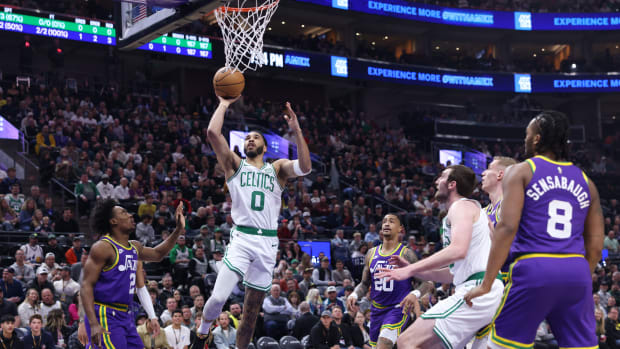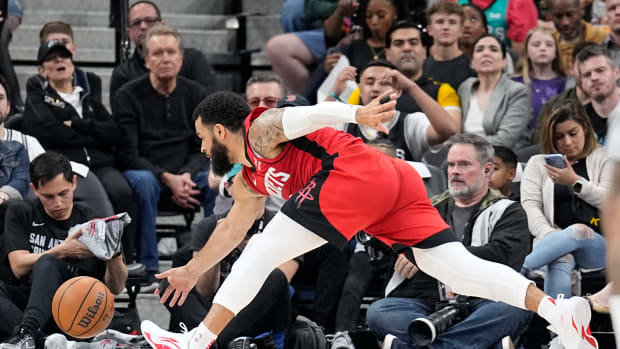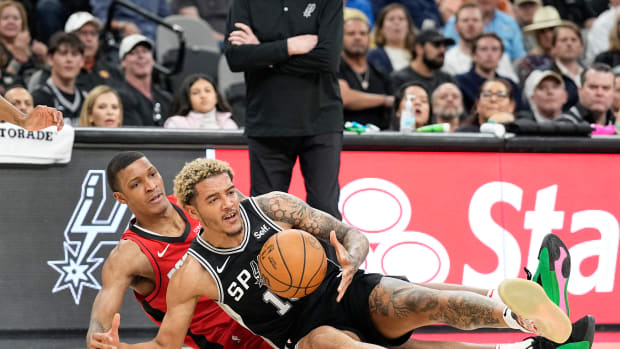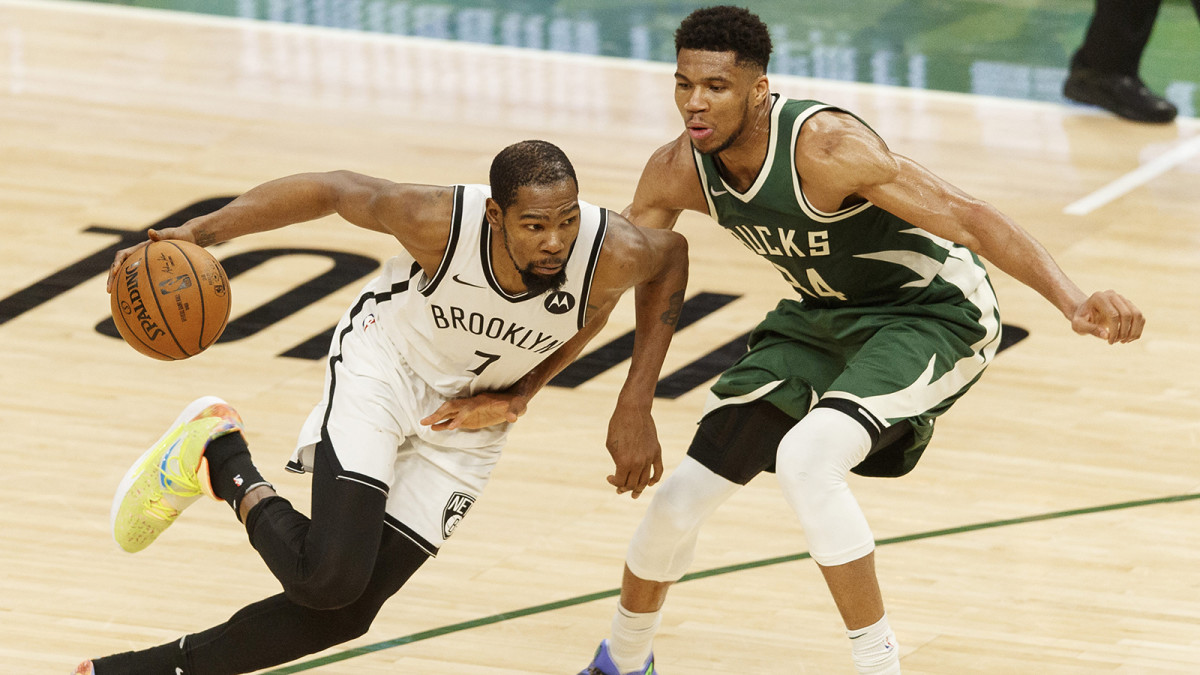
Welcome to the Most Unpredictable Finish in NBA History
Welcome to the Morning Shootaround, where every weekday you’ll get a fresh, topical column from one of SI.com’s NBA writers: Howard Beck on Mondays, Chris Mannix on Tuesdays, Michael Pina on Wednesdays, Chris Herring on Thursdays and Rohan Nadkarni on Fridays.
Between the short offseason, the shorter schedule, an enduring coronavirus and the playoffs’ being structured differently this year, there was never much chance of the 2020–21 NBA campaign being “normal.”
As a result of the chaos, we’re approaching perhaps the most unpredictable finish in league history.
The reigning champs are in an absolute brawl to avoid having to participate in the postseason’s play-in round. The Knicks, usually left for dead this time of year, have been among the hottest teams in the association, taking blowtorches to defenses a number of times in recent weeks. One borough over, the Nets possess the NBA’s most talented trio but, despite establishing that group months ago, have only seen its core together in seven games, making them the equivalent of a Mario Mystery Box. Arguably the best, most stable club all year has been the Suns, which will be making its first playoff appearance in a decade.
Taking all this into account, FiveThirtyEight’s projection model has been left scratching its head a bit more than usual this time of year. While it pegs the Clippers as the favorite to take the crown, with a 23% probability of getting the job done, that’s only a touch higher than the Sixers, at 21%—a bit of a contrast from March 2020, when the eventual-champion Lakers were favored at 28% (and the Clippers behind them at 22%) just before the sports world came to a screeching halt due to the pandemic. To give the ’20–21 Clippers’ 23% probability more context, consider this: Since the model was created in ’16–17, the rate marks the lowest of any “favorite” going into the final weeks of a regular season.
In a way, we shouldn’t be surprised. This year has been extremely strange and the numbers bear that out. We wrote recently that the league has seen more post–All-Star break blowouts than it has in 53 years. A fair amount of that would seem to stem from availability. Players who made this season’s All-Star Game have missed almost 18% of their games, the highest rate in history, according to Stats Perform. (Another oddity, per Stats Perform: We’ve had to pull back on the presumption of home-court advantage. Road teams have won a record-high 46.5% of games so far this year with fewer fans to ruffle their feathers.)
The Lakers learned just how quickly the bottom can fall out of things when you’re without your top guns. Even after losing Anthony Davis midway through February (reaggravated Achilles injury), Los Angeles owned a 28–13 mark, tied for the NBA’s second-best, heading into its March 20 game with the Hawks. Then disaster in the shape of Solomon Hill struck, buckling the right leg of LeBron James, and resulting in a high-ankle sprain that would rob the remarkably durable superstar of 20 consecutive games.
By the end of the first night he and Davis took the court together again, the Lakers were in fifth in the West, just one game away from seventh, which would require them to take a win-and-you’re-in contest to solidify a postseason spot. (Just as bad if not worse: The 36-year-old James reaggravated his ankle injury in that second game back, leaving the club in a lurch but also putting Davis and James in spots where they’ll feel more pressure to play hard while being at higher risk for a bad injury. The scenario is far from ideal.)
Speaking of teams with stars who’ve been unable to stay healthy, the Nets—assuming they have their Big Three in full effect by then—will be a case study in how much cohesion a team needs to make a title run.
Kevin Durant, Kyrie Irving and James Harden were unstoppable in seven games together, lighting teams up for more than 120 points per 100 possessions while logging a true-shooting percentage of 64. In other words, a lineup that scored with the efficiency of MVP frontrunner Nikola Jokić, except on a team scale.
It’s fair to wonder all sorts of things about Brooklyn. Can the club get through the East without having to play good defense? Will Harden be back before the playoffs? Is it possible to build rhythm out of thin air? (Perhaps it’s easier and less of an issue when you have three guys who can score on their own, without motion?) And, crazy as it sounds, can the Nets contend if one of Harden, Durant or Irving has to sit out?
Regular season clearly isn’t the postseason. But aside from the trio, which has beaten teams by 8.1 points per 100 plays in 186 minutes, two-person combos from that group have won by 7.3 points per 100. Even with just one of Durant, Harden or Irving, Brooklyn’s won by 6.1 points per 100, per Stats Perform.
For the first time in a decade, the Knicks are going to reach the playoffs as an elite defense. Little is expected of them once they get there. (Perhaps a first-round victory if they draw Atlanta in Round 1.) Yet all of a sudden, Derrick Rose and others—who’ve won 12 of their last 14 games—have been scoring at an elite clip lately, too, which could give New York just enough two-way balance to be an annoyingly tough out in the second round for whoever comes away with the Eastern Conference’s top seed.
One of the more interesting story lines developing in the playoff race out West: With James, Davis and the Lakers desperately trying to land either the fifth or the sixth spot to avoid the play-in game(s), there’s a better-than-decent chance they could end up playing the Clippers in the first round.
Aside from the star power it would possess, the matchup would also provide a showdown that many, dating back to the beginning of last season, figured would come during the conference-finals round. For everything that went wrong last postseason—when they blew a 3–1 lead to the Nuggets—the Clippers look considerably different in a handful of ways.
It would make for arguably the most star-studded first-round matchup we’ve seen in recent memory, between James, Davis and the reigning champs, and Kawhi Leonard, Paul George and the Staples Center–sharing Clippers, who look every bit of a contender. One thing that looks fundamentally different for the moment: the Clips have a pair of guys who’ve essentially forgotten how to miss from outside.
Of the league’s players who’ve taken at least five triples per game since the All-Star break, the Clippers boast the two guys shooting the best: Marcus Morris (48.2%) and Reggie Jackson (47.1%). Their ability to maintain that sharpshooting or even something close to it, would make for a night-and-day difference from the ice-cold shooting that ultimately cost Los Angeles in the second round last season.
Obviously a handful of other things could be parsed, too. Momentarily putting aside Brooklyn’s health, how high is the Philadelphia’s ceiling at full strength? (The Sixers’ starting lineup—finally fully healthy again—has quietly gone 25–4 this season.) Will there be a breakthrough for Giannis Antetokounmpo and the Bucks, who have overhauled their offense and willingly taken their occasional lumps in hopes of making their attack playoff-proof? How capable is Jokić of carrying Denver without Jamal Murray? (And can the second-year Michael Porter Jr. continue replacing Murray’s scoring?)
But for how ridiculous this season has been, perhaps the real question is this: Will we look back on this year and realize the eventual champion was in plain sight the entire time?
At first glance, the Jazz—which dominated opponents for long stretches this season, and remain the only team in the league to have avoided a three-game skid all year—are that club. They get up triples at a clip that’s hard to match, have the best rim protector (if not defender) in the sport, and finally appear to have the ballhandling and scoring support surrounding Donovan Mitchell (who remains out) to make the push.
But Phoenix deserves to be in that conversation just as much. The Suns—one game back of Utah for the NBA’s best mark—have knocked off the Jazz three times this year (once without Mike Conley and Donovan Mitchell). They have more lineup cohesion than any club, with their top four having played more minutes together than any other NBA foursome by nearly 150 minutes. They have a top-five defense, and a fluid offense that gets into the midrange crevices the Jazz are generally ceded out of analytical habit.
Even after last season’s 8-0 bubble run, the Suns’ lack of playoff experience will obviously be called into question. But honestly, in this bizzaro NBA season—when cohesion might be optional, road games are as neutral as they’ve ever been and the postseason operates differently with the play-in format—it would make total sense if the answer to this strange riddle is staring us in the face already. Only time will tell.
More NBA Coverage:
• Mannix: Sorry LeBron, the Play-in Is Here to Stay
• Power Rankings: Time to Worry About the Lakers?
• Pina: Zion Is Hard to Ref
• Prewitt: Do Triple-Doubles Really Matter?






























